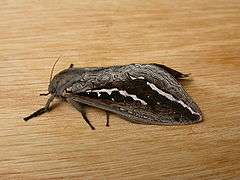Trictena atripalpis
| Trictena atripalpis | |
|---|---|
 | |
| Scientific classification | |
| Kingdom: | Animalia |
| Phylum: | Arthropoda |
| Class: | Insecta |
| Order: | Lepidoptera |
| Family: | Hepialidae |
| Genus: | Trictena |
| Species: | T. atripalpis |
| Binomial name | |
| Trictena atripalpis (Walker, 1856) | |
| Synonyms | |
| |
Trictena atripalpis, also known as bardee, bardy, bardi grub, rain moth or waikerie is a moth of the Hepialidae family. It is found in the whole southern half of Australia.
The caterpillar is used extensively by fishermen as bait. This is where the common name "bardee", "bardi", "badee", or "bargi grub" is derived from. This name is also used for the larva of the beetle Bardistus cibarius, Cerambycid species, as well as various ground dwelling and wood boring moth larvae. The other common name, "rain moth", stems from the fact that adults often emerge after rain, typically in autumn.[1]
The wingspan is about 120 mm for males and 160 mm for females. The moths have fawn wings with two silver flash markings across each forewing.[2]
The adult females deposit a great number of eggs. In one instance, a dissected female carried over 40,000.
The larvae feed on Casuarina pauper and Eucalyptus species, especially Eucalyptus camaldulensis.[3]
References
- ↑ Don Herbison-Evans & Stella Crossley (May 26, 2008). "Trictena atripalpis". uts.edu.au. Archived from the original on September 24, 2009. Retrieved 2009-02-11.
- ↑ Don Herbison-Evans & Stella Crossley (May 26, 2008). "Trictena atripalpis". uts.edu.au. Archived from the original on September 24, 2009. Retrieved 2009-02-11.
- ↑ Don Herbison-Evans & Stella Crossley (May 26, 2008). "Trictena atripalpis". uts.edu.au. Archived from the original on September 24, 2009. Retrieved 2009-02-11.